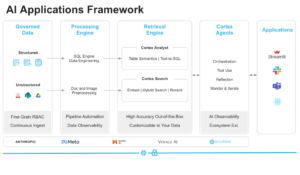As the AI wave starts to crest, companies are looking for ways to help accelerate their AI projects before the wave washes over them. One of the ways companies can get ahead is by adopting tools and frameworks upon which to build their new AI-powered chatbots, co-pilots, and agentic systems.
Building an AI application from scratch is not for the fainthearted. After all, only a few hundred organizations around the world are building foundation AI models. But why stop at using someone else’s open or commercial AI model? There are innumerous other components that go into building agentic workflows.
One vendor that’s seeking to streamline the process of standing up and running an AI application in an enterprise setting is Yurts. According to Ben Van Roo, the company’s co-founder and CEO, the company helps organizations integrate AI models into the day-to-day workflow of Fortune 2000 companies and government departments.
“How do we make this into a software so you can stand up and use these types of copilots across everything you do?” Van Roo says. “It’s data integration, roles-based access controls. You’ve got to manage the models. You’ve got to do analytics around it. It’s basically the plumbing that enables any enterprise to say, how do we have all of our systems consume it?”
In the early days of the generative AI revolution, customers largely moved their data to the large language models (LLMs) to process the data. That doesn’t necessarily work in an enterprise environment. To get the benefit of the emerging tech, the AI must be integrated into existing datasets and workflows, Van Roo says.
“Lots of companies are realizing that to consume these models and get a return on investment, you just have to have it plugged into the applications and workflows people use,” he told BigDATAwire at GTC 2025 last week. “You can have a data scientist stand up an open source example on a data set. But now it’s like, okay, 5,000 or 50,000 people want to use that and 150 other assistants or agents at the company. Like, now what? So [Yurts] is this really interesting maturation of software infrastructure to enable large language models.”
Yurts helps customers’ integrate AI into their enterprise systems, including cloud systems like NetSuite and Salesforce, as well as on-prem ERP software made by companies like Oracle and Infor. It helps to manage the DevOps lifecycle of GenAI via tools as Confluence and Jira, and provides authentication and RBAD to prevent unauthorized access. Yurts helps to manage the deployment of models, and tracks and audits their performance over time.
Yurts has attracted some sizable customers, including the Department of Defense, where it helped to deploy an AI agent system for the United States Special Operations Command a year. As agentic AI technology improves, Yurts is looking to position itself as a trusted provider to help customers deploy and manage AI agents in a controllable manner.
“When you start to combine reasoning models with effective tools, then you actually can take action and do things that are useful,” Van Roo says. “We think that’s where the future is going. There will be open source vendors and they’ll be really good proprietary vendors. But the software to manage that whole kind of chaos is still going to be a pretty interesting market.”
It’s Snowing AI Agents
Another vendor that’s dedicating resources to building out an agentic AI framework is Snowflake.
The company officially unveiled its first agentic AI product, dubbed Cortex Agents, in early February. Cortex Agents are capable of breaking down complex questions and use various processing engines–including new LLMs and reasoning models but also classic SQL and search engines–to deliver a reliable answer. These agents play a key role in the AI application framework that Snowflake is building.
“Data agents are around enabling enterprise workflows,” says Anupam Datta, the principal research scientist at Snowflake and lead of the Snowflake AI Research Team. “Agents usually will make use of tools, and in this example, the tools that we are making use of are the analyst and search tools, which are providing search over structured and unstructured data.”
There are two Cortex Agents, including Cortex Analyst, which uses Anthropic Claude to provide text-to-SQL conversion and generate answers to questions on structure data. For searching through unstructured data, such as PDFs and Word documents, Snowflake offers Snowflake’s own Arctic model.
“We are also building in support for custom tools so that we are not just restricted to our tools, but we can make use of external tools as well,” said Datta, including Meta‘s Llama models, Mistral, and OpenAI GPT, among others.
Many Snowflake customers use it as a data lake, so it makes sense to bring other AI engines into the Snowflake environment. This allows customers to build a variety of agentic workflows using Cortex Agents.
For instance, say a salesperson asks a question via Slack about what are the top AI use cases across 10,000 customers. According to Datta, the Cortex Agent will be capable of breaking the question down into two parts and building the necessary retrieval augmented generation (RAG) workflow to answer it quickly and correctly.
“The first part of the question is looking at tables of structured data, which have rows of information about customers and their use cases, and then figure out like across the 10,000 customers, what use cases are repeated most often,” Datta says. “And then also once you have figured out what the top five AI use cases are, you want the next layer of detail, which will involve reading, let’s say, all the meeting notes which are on Google Drive related to those use cases.
Structured data and unstructured data forms the foundation for answering this question, Datta says, and all of this needs to be in a well-governed state. That gives an advantage to Snowflake’s data lake, he says.
“It puts us in a good place to lead in this area, because what we are seeing in enterprises is that customers care a lot about the governance of their data,” he says. “They don’t want the data to be flying outside of the governance perimeter. And with Snowflake, we get that in a very natural way based on the abstractions that we have.”
Datta says Snowflake has big plans to develop more agentic AI software. It currently uses Anthropic’s Claude 3.5 as the default reasoning model, but it recently brought in Deepseek and will bring in more, the former Carnegie Mellon professor says. But reasoning models are just the start, and a successful agentic AI project will require more than just a reasoning model, he says.
“The reasoning models are helpful in doing steps like orchestration. They’re helpful in as a building block in the text-to-SQL task and then in the summarization step of search,” Datta says. “But they don’t do all the steps.”
Snowflake is innovating at other layers of the AI stack too, such as providing observability of AI models (i.e. detecting abusive responses and grounding answers), and optimizing inference workloads.
“We want to check that every sentence in the summary needs to be grounded in, or are traceable back to those retrieve results, and so we call that groundedness,” says Datta, who was the co-founder, president, and chief scientist at TruEra before Snowflake acquired it in May 2024. “The final answer should also be relevant to the question that was asked. We call that answer relevance, so these are the kinds of metrics that we evaluate on RAGs.”
As the agentic AI era takes off, different vendors will care out niches for themselves to help customers at various parts of the stack. Snowflake will be looking to help customers innovate in a way that’s consistent with its core beliefs. “At Snowflake, our emphasis has been around building an AI platform that is easy to use, that’s efficient, and trusted,” Datta says.
Related Items:
Nvidia Preps for 100x Surge in Inference Workloads, Thanks to Reasoning AI Agents
Snowflake Unleashes AI Agents to Unlock Enterprise Data
Snowflake Looks to AI to Bolster Growth
The post Accelerating Agentic AI Productivity with Enterprise Frameworks appeared first on BigDATAwire.




0 Commentaires